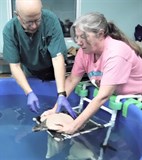
In all honesty, they’re probably only paying attention to us because they think we’re there to deliver a meal. But what can turtles really hear, especially underwater where they do most of their hearing? Since last year some of our patients have been participating in non-invasive research to find answers to that very question.
The project is being conducted by our turtle vet, Dr. Craig Harms along with Charles Muirhead PhD student (Duke) and Wendy Dow Piniak, PhD (NOAA) with funding from the Bureau of Ocean Energy Management (BOEM.) The ocean is a noisy place with naturally occurring sounds including storms and hurricanes. But there’s also a lot of people noise from commercial, recreational, and military activity. Our proximity to Lejeune has desensitized us locals to the “sounds of freedom” but how are sea turtles responding to Coast Guard boats, ordnance, and low flying aircraft?
The research is designed to determine what thresholds sea turtles are most sensitive to; what’s the quietest sound they respond to at each frequency (or as a musician would call it, “pitch”). It’s important to remember that our turtles are not harmed in any way.
The method used is the “Auditory Evoked Potential” (AEP) method, the same one employed to evaluate hearing in babies and non-verbal patients and involves attaching external sensors that measure brain activity. We use our surgical room for the study as it is the quietest spot in our hospital. A large tank of water is rigged with an underwater speaker and a platform where the turtle is secured then lowered and raised in the water as the sounds change. It requires some swaddling of the flippers with additional restraint of a bag for the feisty turtles. There are quite a bit of specialized electronics involved to generate sounds and record data. The equipment is so sensitive that we have to tiptoe around the building as even the sound of a door opening and closing anywhere near the surgery can contaminate the data. Each turtle spends about an hour in the tank to get enough clean readings.
The research is ongoing. Obviously, only our smaller turtles can participate and despite their reputation the Kemp’s have been the most compliant. The greens – they definitely need the bag. It’s pretty cool research and if I were a turtle I’d raise my flipper to volunteer.
Beginning in June we will be open seven days a week: Mon – Fri, Noon-3; Saturday,10-2 and Sunday Noon-2. Tickets MUST be purchased in advance through our website: www.seaturtlehospital.org. Select the date, time, and the number of guests in your party and purchase your tickets. We limit the number of guests for each time to make the experience more enjoyable and to continue our commitment to keeping you and our staff safe as we work our way through Covid. At this point, masks are not required. Sorry, but we are not able to accommodate walk-ups for tours once we sell out for the day. Please keep in mind that summer traffic can be especially heavy on the weekends so plan your arrival accordingly. If you are coming only to our gift shop (not for a tour) you can enter through the single door to the left of the main entrance.
Nesting season has officially arrived, and our Topsail Turtle Project volunteers are out on the beaches before sunrise looking for signs that mama has nested. As of this writing, we have five verified nests on the island. If you spot a nesting mama or anything unusual such as an injured or stranded turtle please call our Director of Beach Operations, Terry Meyer at: 910-470-2880. If she is not available, you may call the hospital during operating hours: 910-329-0222. We will take the information and we will send a trained volunteer to meet you to assess the situation. The State of NC hotline for stranded, sick, and injured turtles is 252-241-7367. The state number picks up 24/7. Please note that all our work with sea turtles, at the hospital and on the beach, is authorized by the NC Wildlife Resources Commission, ES Permit 22ST05.



